Bushmaster snakes are in the Pit Viper family and are one of the largest venomous snakes in the world. Pit vipers are in the subfamily Crotalinae which includes rattlesnakes, water moccasins, copperheads, fer-de-lance, and bushmasters. They all have two fangs and “pits”, openings on the side of their heads that are heat sensitive and serve as a sensing organ to locate prey.
They live in various habitats in North America, South America, and Central America. The Bushmaster is the longest pit viper in the world and lives in Central America, northern South America, and parts of Trinidad. Let’s find out about the largest bushmaster snake ever recorded!
What is a Bushmaster Snake?
The Bushmaster (sometimes called the Atlantic Bushmaster) is a large venomous pit viper that lives in Central and South America in countries like Columbia, Brazil, Ecuador, and Peru. They have beaded scales with a tan base coat and dark brown markings with cream-colored borders. Bushmasters are thick-bodied snakes that weigh between 9-11 pounds and are an average of 6 feet long.
However, some of the largest ones have been measured at nearly 12 feet long! They hunt at night and will hide out along the trails of small mammals waiting for one to trot by. They will strike the prey using their long fangs and release their poisonous venom.
They strike quickly several times in a row releasing large amounts of venom, killing their prey in minutes. Bushmasters eat rodents, birds, and rabbits.
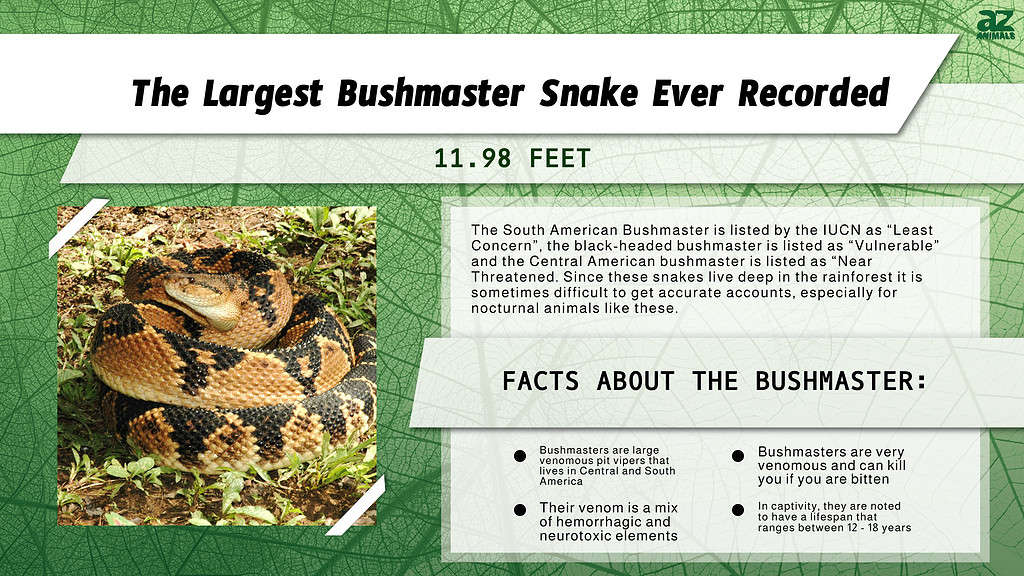
The Largest Bushmaster Snake Ever Recorded
According to the Guinness Book of World Records the largest bushmaster snake ever recorded was 3.65 m (11.98 feet!). For reference, a queen-sized bed is 6 ½ feet long, so if this snake were sleeping in your bed nearly half of it would be on the floor!
Are Bushmasters Dangerous to Humans?
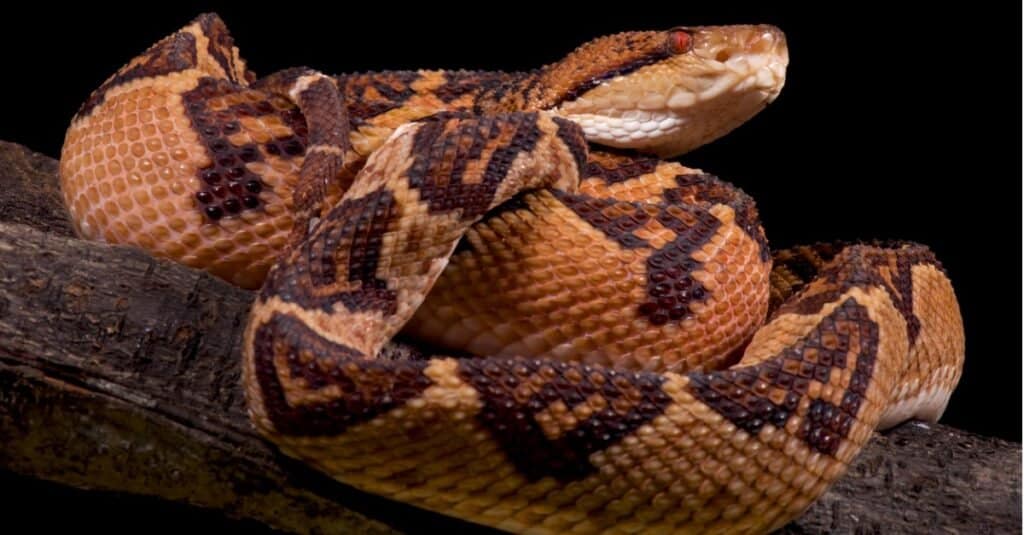
Each species of bushmaster snake has a black line that runs behind its eyes.
©iStock.com/reptiles4all
Yes! Bushmasters are very venomous and can kill you if you are bitten. Researchers continue to try to find a better antivenom that is more specific to the bushmaster’s venom. The venom is a mix of hemorrhagic (blood can’t clot) and neurotoxic (affects the nervous system) elements. The symptoms include pain and swelling at the bite site, dizziness, nausea, vomiting, diarrhea, and excessive sweating.
If not treated the death rate is very high. Luckily the number of people bitten by the Bushmaster is relatively low due to the fact that these snakes are nocturnal and prefer to stay hidden. However, if they do feel threatened they are quick to strike.
They don’t just strike once, they strike multiple times which is what makes them so dangerous. If you have been bitten by a bushmaster be sure to seek immediate medical attention.
How Long Do Bushmasters Live?

Bushmasters can live for over a decade or even slightly under two decades in captivity
©Patrick K. Campbell/Shutterstock.com
No one is quite sure how long bushmasters live on their own out in the wild. However, when provided expert care in captivity, they have been noted to have a lifespan that ranges between 12 – 18 years. Given the fact that they are able to live that long under conditions that are as conducive as can be to a comfy lifestyle, we may surmise that their lifespan in the wild is a lot shorter.
Compared to other well-known species, such as copperheads or diamondback rattlesnakes, for example, they are relatively short-lived. The former is capable of living up to 25 years in the wild, while the latter is capable of living for 20 years.
Do Bushmasters Live in the United States?
No. Bushmasters live in Central and South America. They have not made it as far north as the United States due to their preference for hot and wet climates that occur in many of the rainforests in Central and South America.
Do Venomous Snakes Live in the United States?
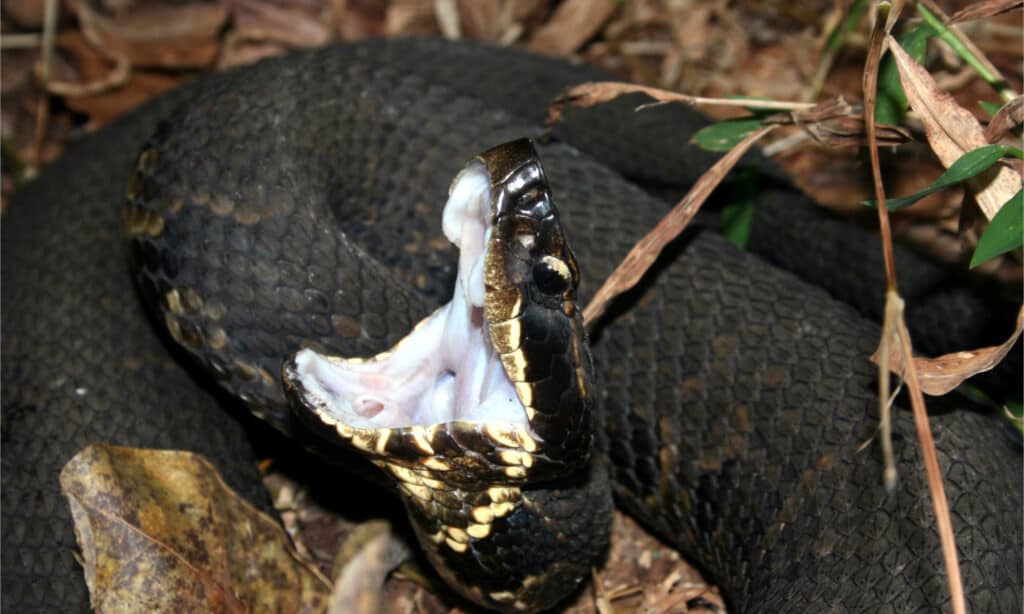
Cottonmouths are doubly dangerous due to the fact that they can attack on land and in the water. They are also called water moccasins.
©Psychotic Nature/Shutterstock.com
Yes. There are over 30 different venomous snake species in the United States that fall into one of the four categories of a rattlesnake, copperhead, cottonmouth, or coral snake. Rattlesnakes, copperheads, and cottonmouths are all pit vipers like the Bushmaster, but the coral snake is from a different family. The top ten most dangerous snakes in the US are:
- Eastern diamondback rattlesnake
- Western diamondback rattlesnake
- Coral snake
- Texas coral snake
- Copperhead snake
- Cottonmouth (water moccasin)
- Timber rattlesnake
- Mojave rattlesnake
- Massasauga rattlesnake
- Prairie rattlesnake
What is the Largest Venomous Snake in the US?

Eastern diamondback rattlesnakes’ are the largest venomous snake in the US with some getting to be more than 30 pounds.
©Chase D’animulls/Shutterstock.com
The largest venomous snake in the US is the Eastern diamondback rattlesnake. They are heavier snakes than the bushmaster but not as long. Eastern diamondbacks are typically 5-6 feet long and have an average weight of around 5 pounds.
However, there have been multiple samples found and recorded as being longer than 7 feet. In 1946, an Eastern Diamondback was shot and measured at 7.8 feet and the massive snake weighed 34 pounds! In the US, these snakes only live in the southeast corner of the country in all of Florida and parts of South Carolina, Georgia, Alabama, and Mississippi.
What is the Largest Venomous Snake in the World?
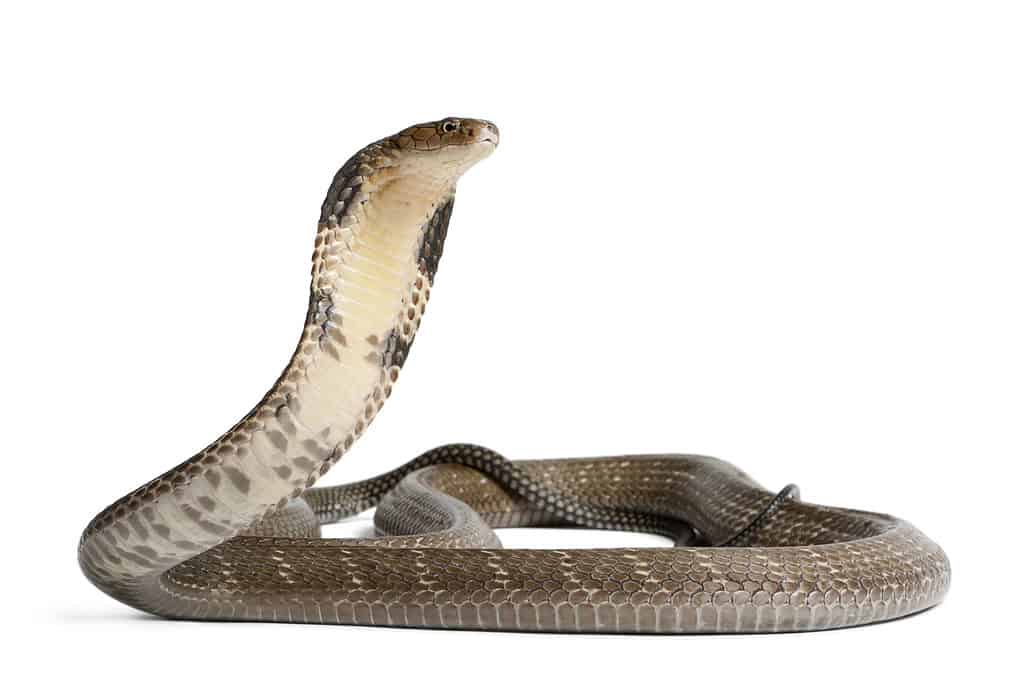
The King Cobra is the longest venomous snake in the world, but they do not live in the US.
©Eric Isselee/Shutterstock.com
The largest venomous snake in the world is the king cobra. Even an average king cobra is impressive at 12-15 feet long, but the largest one ever recorded was 18.7 feet long! It was found in Negeri Sembilan in Malaysia and shipped to a zoo in London where it was measured and kept on display.
Unfortunately, it was at the same time as World War II and the zookeepers had to put it down to avoid the risk of it getting loose during a bombing. King cobras have a wide hood that makes their heads look even bigger and they can raise the front part of their body off the ground. They live in South and Southeast Asia.
What is the Largest Snake in the World?
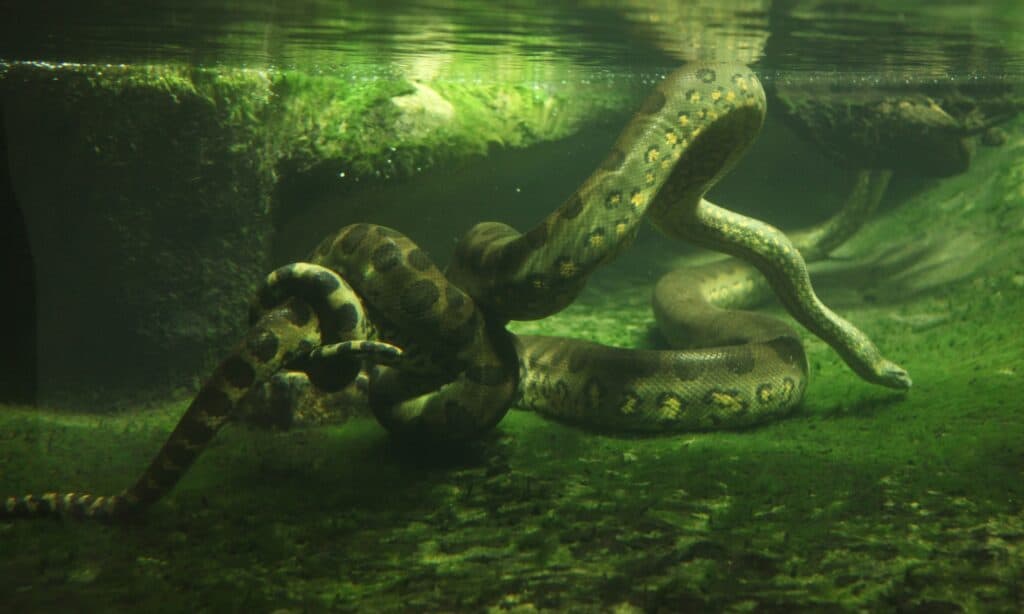
Green Anacondas spend much of their time in the water. They can get up to 22 feet long!
©Vladimir Wrangel/Shutterstock.com
The largest snake in the world is the Green Anaconda. These snakes can get to be 22 feet long and weigh 500 pounds! Now that is a big snake! They are really thick-bodied snakes and are surprisingly good swimmers. They live in the rainforests of South America and Trinidad.
Their territories do overlap with the Bushmaster. Green anacondas are non-venomous and are constrictor snakes instead. They wrap their large bodies around their prey and squeeze, cutting off the blood flow so the prey dies. Once the prey is dead they swallow it whole.
Are Bushmasters Endangered?
The South American Bushmaster is listed by the IUCN as “Least Concern”, the black-headed bushmaster is listed as “Vulnerable” and the Central American bushmaster is listed as “Near Threatened. Since these snakes live deep in the rainforest it is sometimes difficult to get accurate accounts, especially for nocturnal animals like these.
Conservationists continue to try to protect the rainforests to limit habitat loss for all the animals that call them home, even the dangerous bushmasters.
Other Record-Breaking Snakes
Ribbon snakes, a type of non-venomous snake, are known for their slender bodies that can grow to an average length of 16 to 35 inches (41 to 89 cm) when they reach adulthood. However, among the four subspecies of ribbon snakes, the western ribbon snake is the largest, with a measurement of about 18 to 42 inches long.
In fact, the maximum recorded length for a western ribbon snake is 42 inches (107 cm), which includes the tail that comprises approximately 30% of the total body length. As an agile species, the ribbon snake can move quickly and effortlessly in water, making it an excellent swimmer.
These snakes are commonly found near streams, rivers, and wetlands, where they hunt small fish, frogs, and tadpoles. In terms of appearance, ribbon snakes have a distinct pattern of three yellow stripes running down their brown or black bodies, making them easy to identify.
The photo featured at the top of this post is © iStock.com/Luis Espin
Discover the "Monster" Snake 5X Bigger than an Anaconda
Every day A-Z Animals sends out some of the most incredible facts in the world from our free newsletter. Want to discover the 10 most beautiful snakes in the world, a "snake island" where you're never more than 3 feet from danger, or a "monster" snake 5X larger than an anaconda? Then sign up right now and you'll start receiving our daily newsletter absolutely free.
Thank you for reading! Have some feedback for us? Contact the AZ Animals editorial team.






